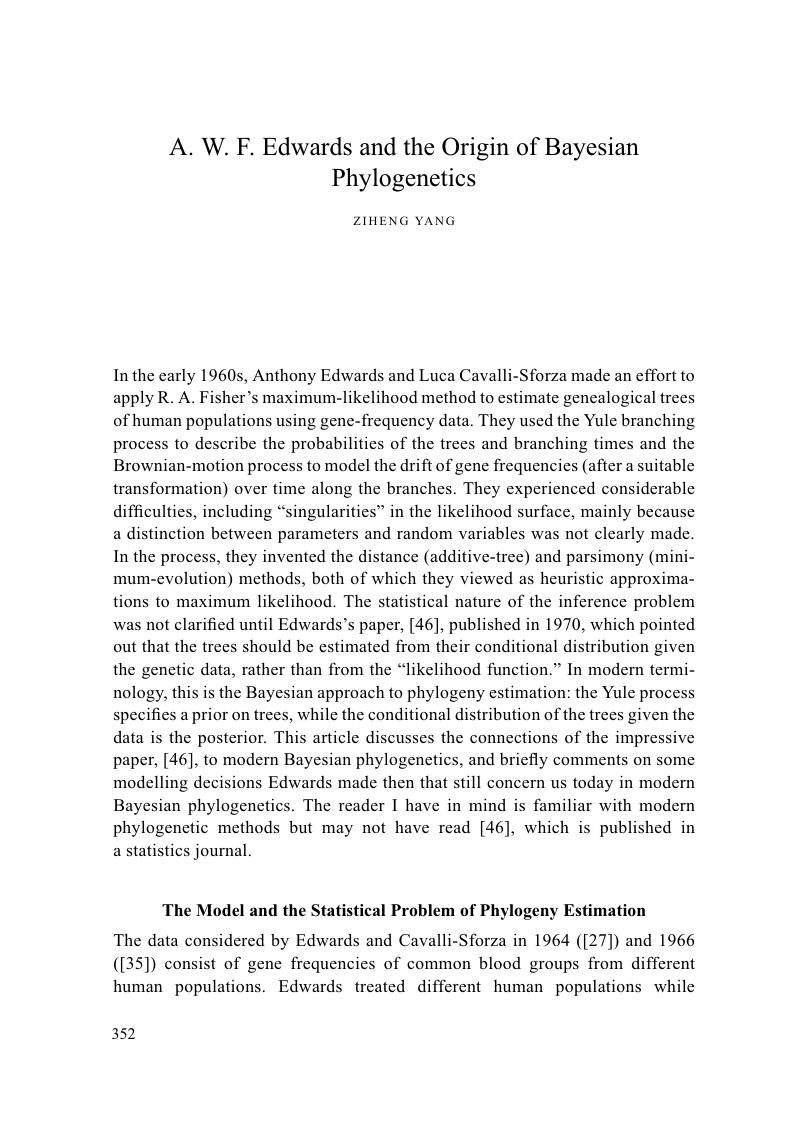 Phylogenetic Inference, Selection Theory, and History of Science
Phylogenetic Inference, Selection Theory, and History of Science Book contents
- Phylogenetic Inference, Selection Theory, and History of Science
- Frontispiece
- Phylogenetic Inference, Selection Theory, and History of Science
- Copyright page
- Contents
- Selected Featured Papers of A. W. F. Edwards
- Contributors
- Dedication
- Introduction
- Part 1 Selected Papers of A. W. F. Edwards
- Part 2 Commentaries
- Anthony Edwards’s Seminal Contributions to Phylogenetics, Likelihood, and Understanding R. A. Fisher and the History of Genetics
- Anthony Edwards, Luca Cavalli-Sforza, and Phylogenies
- The Historic Split and Merger of Gene Trees and Species Trees
- Likelihood and the Comparative Method in Evolutionary Biology
- Likelihood Inference in Models for the Genetic Diversity of Populations
- A. W. F. Edwards and the Origin of Bayesian Phylogenetics
- A Conversation about Fisher (1930, 1958)
- Edwards on Fisher’s Fundamental Theorem of Natural Selection
- A. W. F. Edwards, R. A. Fisher, and The Genetical Theory of Natural Selection
- Reading and Misreading Fisher: Anthony Edwards and the History of Population Genetics
- Variance-Partitioning and Classification in Human Population Genetics
- Part 3 Interviews with A. W. F. Edwards
- Part 4 A. W. F. Edwards
- Book part
- Index
- References
A. W. F. Edwards and the Origin of Bayesian Phylogenetics
from Part 2 - Commentaries
Published online by Cambridge University Press: 29 June 2018
- Phylogenetic Inference, Selection Theory, and History of Science
- Frontispiece
- Phylogenetic Inference, Selection Theory, and History of Science
- Copyright page
- Contents
- Selected Featured Papers of A. W. F. Edwards
- Contributors
- Dedication
- Introduction
- Part 1 Selected Papers of A. W. F. Edwards
- Part 2 Commentaries
- Anthony Edwards’s Seminal Contributions to Phylogenetics, Likelihood, and Understanding R. A. Fisher and the History of Genetics
- Anthony Edwards, Luca Cavalli-Sforza, and Phylogenies
- The Historic Split and Merger of Gene Trees and Species Trees
- Likelihood and the Comparative Method in Evolutionary Biology
- Likelihood Inference in Models for the Genetic Diversity of Populations
- A. W. F. Edwards and the Origin of Bayesian Phylogenetics
- A Conversation about Fisher (1930, 1958)
- Edwards on Fisher’s Fundamental Theorem of Natural Selection
- A. W. F. Edwards, R. A. Fisher, and The Genetical Theory of Natural Selection
- Reading and Misreading Fisher: Anthony Edwards and the History of Population Genetics
- Variance-Partitioning and Classification in Human Population Genetics
- Part 3 Interviews with A. W. F. Edwards
- Part 4 A. W. F. Edwards
- Book part
- Index
- References
Summary

- Type
- Chapter
- Information
- Phylogenetic Inference, Selection Theory, and History of ScienceSelected Papers of A. W. F. Edwards with Commentaries, pp. 352 - 362Publisher: Cambridge University PressPrint publication year: 2018


